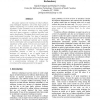688 search results - page 65 / 138 » Using reinforcement learning to adapt an imitation task |
IAT
2005
IEEE
14 years 1 months ago
2005
IEEE
This paper explains the building of robust software using multiagent reputation. One of the major goals of software engineering is to achieve robust software. Our hypothesis is th...
NIPS
2008
13 years 9 months ago
2008
We use graphical models and structure learning to explore how people learn policies in sequential decision making tasks. Studies of sequential decision-making in humans frequently...
ROBOCUP
2000
Springer
13 years 11 months ago
2000
Springer
Q-learning, a most widely used reinforcement learning method, normally needs well-defined quantized state and action spaces to converge. This makes it difficult to be applied to re...
ICRA
2010
IEEE
13 years 6 months ago
2010
IEEE
Multi-robot systems researchers have been investigating adaptive coordination methods for improving spatial coordination in teams. Such methods adapt the coordination method to th...
IUI
1997
ACM
14 years 19 hour ago
1997
ACM
This paper describes ActionStreams, a system for inducing task models from observations of user activity. The model can represent several task structures: hierarchy, variable sequ...

